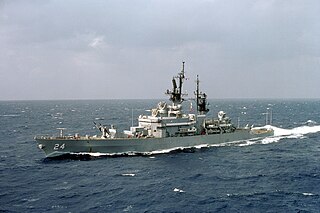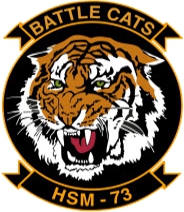Related Research Articles

A carrier battle group (CVBG) is a naval fleet consisting of an aircraft carrier capital ship and its large number of escorts, together defining the group. The CV in CVBG is the United States Navy hull classification code for an aircraft carrier.
The United States Navy, United States Coast Guard, and United States National Oceanic and Atmospheric Administration (NOAA) use a hull classification symbol to identify their ships by type and by individual ship within a type. The system is analogous to the pennant number system that the Royal Navy and other European and Commonwealth navies use.

A naval ship is a military ship used by a navy. Naval ships are differentiated from civilian ships by construction and purpose. Generally, naval ships are damage resilient and armed with weapon systems, though armament on troop transports is light or non-existent.

USS Reeves (DLG/CG-24), a United States Navy ship named after Admiral Joseph Mason Reeves, was a Leahy-class cruiser built by the Puget Sound Naval Shipyard, in Bremerton, Washington.

A warship or combatant ship is a ship that is built and primarily intended for naval warfare. Usually they belong to the navy branch of the armed forces of a nation, though they have also been operated by individuals, cooperatives and corporations. As well as being armed, warships are designed to withstand damage and are typically faster and more maneuverable than merchant ships. Unlike a merchant ship, which carries cargo, a warship typically carries only weapons, ammunition and supplies for its crew.

The Spruance-class destroyer was developed by the United States to replace the many World War II–built Allen M. Sumner- and Gearing-class destroyers, and was the primary destroyer built for the United States Navy during the 1970s and 1980s. It was named in honor of U.S. Navy Admiral Raymond A. Spruance, who successfully led major naval battles in the Asiatic-Pacific Theater during World War II such as the Battle of Midway and the Battle of the Philippine Sea.

Surface warfare is naval warfare involving surface ships. It is one of the four operational areas of naval warfare, the others being underwater warfare, aerial warfare, and information warfare. Surface warfare is the oldest and most basic form of naval warfare, though modern surface warfare doctrine originated in the mid-20th century.

The United States Navy reclassified many of its surface vessels in 1975, changing terminology and hull classification symbols for cruisers, frigates, and ocean escorts.
The names of commissioned ships of the United States Navy all start with USS, for United States Ship. Non-commissioned, primarily civilian-crewed vessels of the U.S. Navy under the Military Sealift Command have names that begin with USNS, standing for United States Naval Ship. A letter-based hull classification symbol is used to designate a vessel's type. The names of ships are selected by the Secretary of the Navy. The names are those of states, cities, towns, important persons, important locations, famous battles, fish, and ideals. Usually, different types of ships have names originated from different types of sources.

An anti-submarine warfare carrier is a type of small aircraft carrier whose primary role is as the nucleus of an anti-submarine warfare hunter-killer group. This type of ship came into existence during the Cold War as a development of the escort carriers used in the ASW role in the North Atlantic during World War II.
The Force d'action navale is the 9,600-man and about 100-ship force of surface warships of the French Navy. As of August 2023, it is commanded by L’amiral Nicolas Vaujour.

The Moskva class, Soviet designation Project 1123 Kondor (condor) and S-703Project 1123M Kiev, was the first class of operational aircraft carriers built by the Soviet Union for the Soviet Navy.

Naval tactics and doctrine is the collective name for methods of engaging and defeating an enemy ship or fleet in battle at sea during naval warfare, the naval equivalent of military tactics on land.

Anti-surface warfare is the branch of naval warfare concerned with the suppression of surface combatants. More generally, it is any weapons, sensors, or operations intended to attack or limit the effectiveness of an adversary's surface ships. Before the adoption of the submarine and naval aviation, all naval warfare consisted of anti-surface warfare. The distinct concept of an anti-surface warfare capability emerged after World War II, and literature on the subject as a distinct discipline is inherently dominated by the dynamics of the Cold War.

The People's Liberation Army Navy Surface Force is the surface warfare branch of China's People's Liberation Army Navy (PLAN), consisting of all surface vessels in operational service with the PLAN. The PLAN Surface Force operates 661 ships organized into three fleets: the North Sea Fleet, the East Sea Fleet and the South Sea Fleet.

A carrier strike group (CSG) is a type of carrier battle group of the United States Navy. It is an operational formation composed of roughly 7,500 personnel, usually an aircraft carrier, at least one cruiser, a destroyer squadron of at least two destroyers or frigates, and a carrier air wing of 65 to 70 aircraft. A carrier strike group also, on occasion, includes submarines, attached logistics ships and a supply ship. The carrier strike group commander operationally reports to the commander of the numbered fleet, who is operationally responsible for the area of waters in which the carrier strike group is operating.
The TF-2000-class destroyer is a projected anti-air warfare guided-missile destroyer currently undergoing development by the Turkish Naval Institute. The class will provide survivability in the presence of aerial threat and also support mission functions such as command, control, and communications, reconnaissance, early warning, surface warfare, anti-submarine warfare and electronic warfare. Moreover, once in service, the TF-2000s are slated to be an integral part of Türkiye's expeditionary strike groups centered around the TCG Anadolu LHD and the country's future aircraft carrier(s). The TCG Anadolu is to be followed up by the TCG Trakya light aircraft carrier and President Erdoğan has also hinted at the construction of a larger aircraft carrier that is to be designed in cooperation with Spain. These capital vessels require destroyer escorts to defend them against enemy aircraft, ships and submarines; in other words, the perfect role for the TF-2000s once these new designs are slated for operational service by 2038. On 5 December 2007, Defence Industry Executive Committee approved plans to build six ships of this class. In January 2013, it was announced that Turkey was planning to acquire a total of 8 TF-2000 destroyers, which was confirmed at the International Defence Industry Fair (IDEF) 2021. With the realization of the project, it is intended to improve the anti-air warfare (AAW) capabilities of the Turkish Navy.

The United States Navy (USN) is the maritime service branch of the United States Armed Forces and one of the eight uniformed services of the United States. It is the world's most powerful navy and the largest by tonnage, at 4.5 million tons in 2021 and in 2009 an estimated battle fleet tonnage that exceeded the next 13 navies combined. It has the world's largest aircraft carrier fleet, with 11 in service, 1 undergoing trials, two new carriers under construction, and six other carriers planned as of 2024. With 336,978 personnel on active duty and 101,583 in the Ready Reserve, the U.S. Navy is the third largest of the United States military service branches in terms of personnel. It has 299 deployable combat vessels and about 4,012 operational aircraft as of July 18, 2023.

Helicopter Maritime Strike Squadron 73 (HSM-73) is a United States Navy Maritime Strike helicopter squadron based on Naval Air Station North Island, California.
References
- ↑ Surface Combatant Force Requirement Study. Federation of American Scientists, Military Analysis Network, US Navy ships. Updated 1998-04-19. Retrieved 2009-08-29.